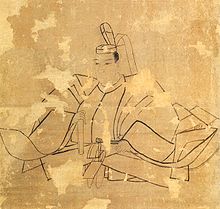Tokugawa Ietsuna
Tokugawa Ietsuna ( Japanese 徳 川 家 綱 ; * September 7, 1641 as Tokugawa Takechiyo ( 徳 川 竹 千代 ); † June 4, 1680 ) was the fourth Shogun of the Tokugawa Shogunate in Japan from 1651 to 1680 .
Early life (1641-1651)
He was the eldest son of Tokugawa Iemitsu and thus grandson of Tokugawa Hidetada and great-grandson of Tokugawa Ieyasu . His mother was a concubine . At that time his father was a Shogun and had issued several anti-Christian measures after the suppressed Shimabara uprising of 1637. Ietsuna was therefore born into a very hostile environment. Tokugawa Ietsuna was a very weak and fragile child and his health problems dragged on into his later life. Ietsuna grew up in Edo .
Reign as Shogun (1651–1663)
Tokugawa Iemitsu died in 1651 before his fiftieth birthday. Ietsuna, the rightful heir and successor, was only ten years old at the time. Nevertheless, in 1651 he was appointed the fourth shogun of the Tokugawa dynasty. By the time he came of age, five rulers were to take over the affairs of state on him, including Sakai Tadakatsu , Sakai Tadakiyo , Inaba Masanori, and Matsudaira Nobutsuna , a distant member of the Tokugawa family. In addition, Iemitsu had appointed his half-brother Hoshina Masayuki as advisor.
The first problem the regents had to deal with was the ronin, or "abandoned samurai". During the reign of Shogun Iemitsu, two samurai , Yui Shosetsu and Marubashi Chūya, had planned an uprising in which Edo was burned, Edo Castle attacked and the Shogun and other family members and high officials were to be executed. Something similar had been planned for Kyoto and Osaka .
However, the plan was uncovered after the death of Iemitsu, and the ensuing rebellion (the Keian uprising of 1651) brutally suppressed. Chūya and Shōsetsu, as well as their families and supporters, were executed. A survey of about 800 abandoned samurai on Sado Island the following year also failed.
In 1657, when Ietsuna was almost 20 years old, a great fire broke out in Edo, which burned large parts of the city up to the main tower of the castle and claimed around 100,000 victims. Zacharias Wagener , the German-born branch manager of the Dutch trading office Dejima , was just in Edo for the annual show of respect. The dramatic description in his official diary was presented to the European reading public by Arnoldus Montanus in 1669. During the reconstruction of the city, which was monitored by government officials, greater attention was paid than before to fire hazards. In 1659 Shogun Ietsuna directed the opening ceremonies.
Struggle for power (1663–1671)
In 1663 the reign of Ietsuna ended, but the regents kept power in their hands. This marked the first time that the power behind the Bakufu was not a former shogun. Ietsuna's main advisors were now Hoshina Masayuki , Ietsuna's uncle whom he held in high regard , Itakura Shigenori , Tsuchiya Kazunao , Kuze Hiroyuki and Inaba Masanori . Since Ietsuna now ruled itself pro forma, the five regents officially became his advisers and in some cases acted for him. In some other cases, however, Ietsuna acted independently e.g. B. with the abolition of Junshi , after which a samurai followed his master (ideally) to death.
One example is in 1671, when the Sendai Date family was embroiled in an inheritance dispute that intervened in Bakufu and prevented a second Ōnin war . By 1671 many of the previous rulers had either died or resigned and Ietsuna began to rule by himself.
Late years (1671-1680)
Following the Date's succession dispute, the remainder of Ietsuna's reign was quiet, with the exception of a few unruly daimyo .
In 1679 Shogun Ietsuna fell ill. His line of succession began to be discussed, with Sakai Tadakiyo playing an active role. He suggested that a son of Emperor Go-Sai should become the next Shogun. This had parallels in the late Kamakura shoguns, who were royal blood. Tadakiyo may have seen himself as powerful as the Hōjō rulers, and so many Tokugawa preferred the son of Shōgun Iemitsu and Ietsuna's younger brother, Tokugawa Tsunayoshi , as the new shogun. Tadakiyo angrily withdrew and shortly afterwards Ietsuna died in 1680 . His younger brother followed him in office.
Although Ietsuna would likely have made a capable leader, his affairs were controlled by the regents appointed by his father, even after Ietsuna was declared old enough to rule himself.
| personal data | |
|---|---|
| SURNAME | Tokugawa, Ietsuna |
| ALTERNATIVE NAMES | 徳 川 家 綱 (Japanese); 徳 川 竹 千代 (Japanese, childhood name); Tokugawa Takechiyo (childhood name) |
| BRIEF DESCRIPTION | Japanese shogun |
| DATE OF BIRTH | September 7, 1641 |
| DATE OF DEATH | June 4, 1680 |
